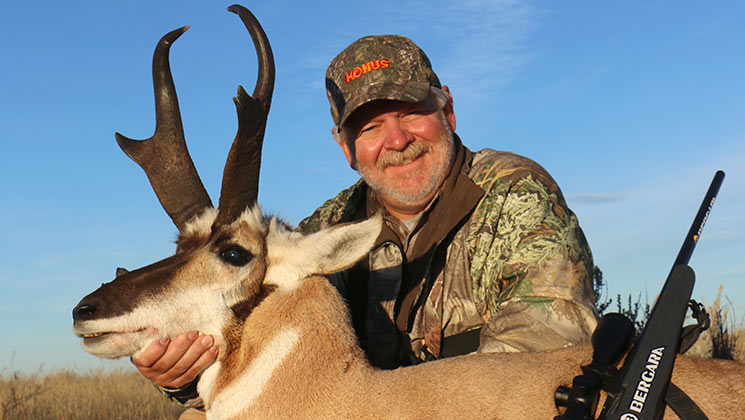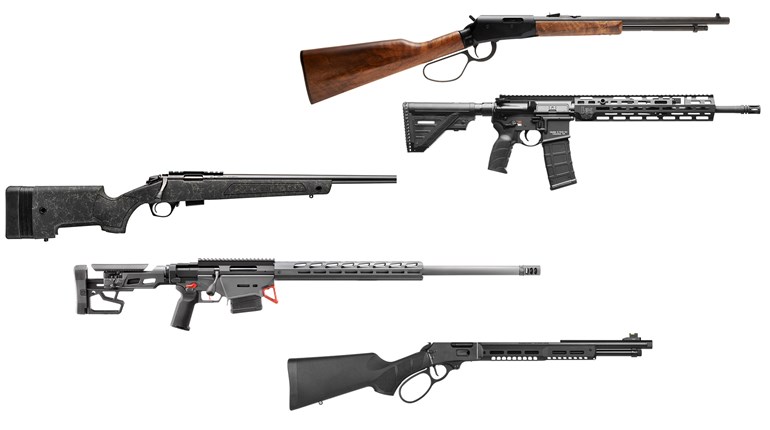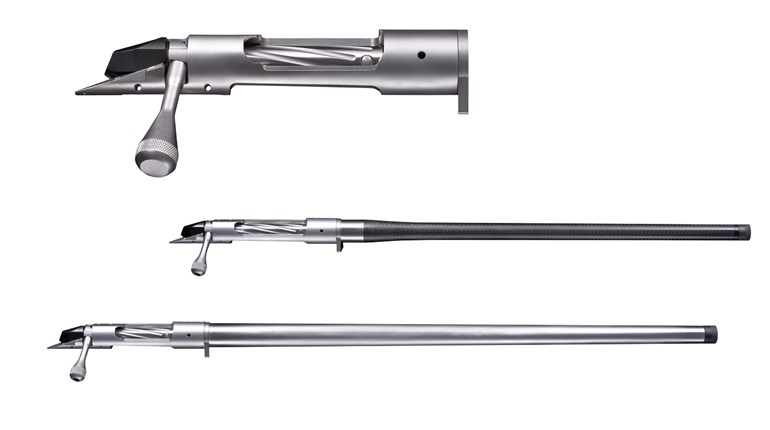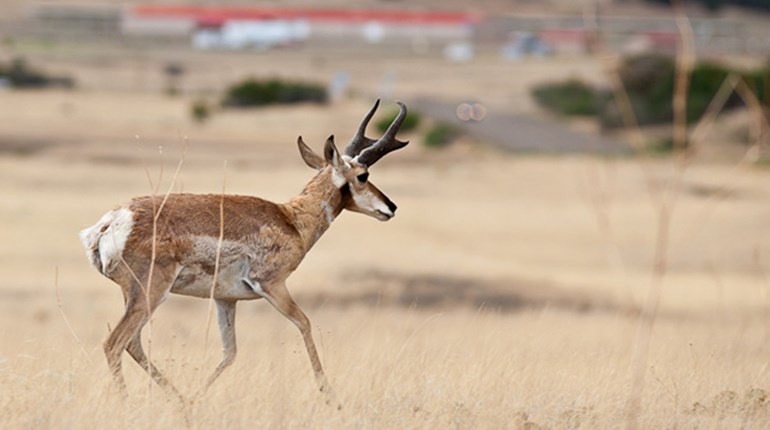
On the afternoon before Alberta’s Monday opener of pronghorn season, guides Phil Baumung and Justin Eckert are making a final scouting run. Long-time friends reunited for another hunting season, they mercilessly razz each other, verbal barbs and name-calling flying back and forth across the front seat of Baumung’s pickup.
We had just checked the zero on the new rifle I’ll be using, a Bergara Premier Stalker, and were spending the rest of the afternoon to spot-check pronghorns the guides had scouted: big, mature, heavy-horned bucks the outfitter, Billy Franklin, has kept an eye on for months, years in some cases.
Franklin operates Silver Sage Outfitters out of the tire shop his parents established in 1956 in Brooks, about a two-hour drive east of Calgary. Eckert, his head guide, has worked for him a dozen or so years; Baumung, about the same. Baumung, Eckert and Franklin used to be neighbors in rural Duchess just north of Brooks until four years ago when Baumung moved to Sundre, Alberta, nearer the Rocky Mountains. Eckert, 34, farms near Duchess. Baumung, 38, runs a taxidermy shop, an oilfield-chemical business and cattle. Franklin calls them “friends who just happen to guide for me.”
I ask Baumung why he calls Eckert “Frankie.” “Because without his beard he looks like Frankenstein,” Baumung says. Eckert says his beard, now about “Grizzly Adams length,” was longer, but his wife trimmed it. Eckert is wearing shades, but no hat. His hair is clipped short on the sides, combed across the top. Baumung favors caps, and wears hunting-season stubble.
“We have a lot of bucks spotted,” says Baumung, driving a gravel road. “So now we’re just making sure they’re still around and if anyone else is looking at them.”
“Whoa, for a second,” Eckert says, adding sarcastically, “May I glass that, sir?”
Phil, looking through his binocular out the right side of the pickup, says, “Your head is big in binoculars, by the way. But big only in binoculars.”
“Your IQ is still small, even through binoculars,” Eckert replies. “As you can tell,” Baumung says, looking at me in the rearview mirror, “we’ve been friends a long time.”
There’s a white pickup about a half-mile away on a side road on the south edge of the hayfield where we pulled in to glass a herd of antelope across a fence in a grassy pasture.
“Is there anyone in that pickup?” Baumung asks. “Yeah,” says Eckert, peering through his spotting scope clamped on the window. “He has a spotting scope on his window.”
“Does Franklin have this leased?” I ask.
In Alberta (and several other, but not all, provinces), hunters can’t lease land for hunting nor can they pay or exchange anything to hunt and, on the other side of the coin, landowners can’t charge anything, explains Baumung. “You ask permission and the landowner might say yes or he might say shoot two or he might say you’re not setting foot on his land,” he says.
Alberta regulations stipulate that a private landowner has the right to permit or deny access for any reason, but a leaseholder who farms public land is required to provide reasonable recreational access.
As Baumung drives, Eckert consults a phone app, and they rattle off names of landowners as we pass. They bemoan the loss of prairie to center-pivot irrigation. Southern Alberta is farm country. Fields of canola, striped with windrows awaiting harvest, are visible from the airplane heading to Calgary; fields of peas, hemp, sunflowers, wheat, barley, alfalfa and corn—and cattle grazing on mile after mile of prairie pasture. It’s also oil and natural gas country, wellheads dotting the countryside and oilfield trucks rumbling on backroads.
So the guy in the white pickup may also have permission to hunt here, they say. We have permission to hunt the hayfield, but not the pasture across the fence. “Either he’s here in the morning and we can hunt him or he’s across the fence and we can’t shoot him anyway,” Eckert says, snapping photos with a long-lensed camera.
“He’s close to 80,” says Eckert, estimating the buck’s horns. “He’s round at the base but his tops are flat.”
“That’s not the one you’re after,” Baumung says to me, looking in the rearview mirror. “You’re going to shoot yours on the E-I-D.” Then, after a pause, “And you’ll be done in nine minutes.”
Eckert, in the front passenger seat, and I, in the back driver’s-side seat, groan. “You just jinxed it,” says Eckert.
The EID, the Eastern Irrigation District, was created in 1935 to take over ownership and management of an extensive water-distribution network of canals and reservoirs built by the Canadian Pacific Railroad to support agriculture and add value to the 3 million acres of farmland between Medicine Hat and Calgary granted from the Dominion of Canada as final payment for construction of the national railway.
The irrigation system, the CPR hoped, would draw settlers who would boost agricultural production and assure the railroad long-term revenue from land sales and irrigation payments, not to mention transportation fees for settlers, supplies and farm products. The theory worked, until farm-commodity prices plunged during the economic depression and drought of the 1920s and ’30s and many landowners were forced to default, many forced to leave. The irrigation system was no longer profitable and remaining landowners, believing they could better manage the system, proposed they take over ownership and operation. The result is the EID, which currently owns about 600,000 acres, of which about 530,000 are publicly accessible—as in open to public hunting. All they ask is that the property be respected; don’t drive off roads and numerous two-track trails to wellheads and other oil and gas facilities seemingly never out of sight.
“The Eastern Irrigation District is a fantastic steward of this prairie land,” Franklin said. “They are hunter-friendly, and for a big organization that is a big statement. All of us, residents of Alberta and nonresidents who get to come here and hunt, owe the EID a big ‘thank you’ for the manner in which they manage all this.” The canal system provides water not only for agriculture and livestock, but also for wildlife. Ducks, geese, mule deer, whitetails, elk and pronghorns all flourish because of the EID, he said. “They are wonderful stewards, and it’s just a very fortunate thing to have an area like this. They are very good at what they do.”
Franklin does not rely solely on the EID. He and his family have been around long enough to know many private landowners, many of whom are involved in agriculture and do business with Franklin’s Tires, which has been in operation for 60 years. “So people know who I am and the vast majority of them are wonderful people, just like anyplace else,” he said.
■■■
There is no draw system for nonresidents to hunt pronghorns in Alberta, but there are a very limited number of tags allocated to outfitters each year. “We call it the Alberta advantage,” said Franklin. “You don’t have to draw, you just contact me or any other outfitter who has tags and you can come, provided we have tags when you call.”
It might be slow in getting out, but word is leaking that Alberta is and has been producing wall-hanger pronghorns for years. “We’re right on the northern edge of the antelope range,” Franklin said, and many hunters don’t realize antelope range that far north. “As a matter of fact,” he said, “when I first started outfitting 20-some years ago, one of the buzzlines was that Alberta is the best-kept antelope secret in North America. I’m not sure we’ve gotten far beyond that yet. A lot of people don’t even know we have antelope, to be honest with you, but we do have antelope and some really, really good quality antelope.”
Franklin credits that to three things: a successful management strategy devised by Alberta Environment and Parks, good productive habitat (expanses of rich pasture; good water supply) and strong genetics.
“We have genetically superior animals to begin with,” he said. “And we don’t overharvest so they get to that 5- 6-, even 7-year age structure they have to reach to have the kind of mass we are looking for.”
“I hate to throw scores around because I’ve killed antelope in the low to mid-70s that in my opinion were every bit a trophy,” he said. “It’s hard to put in perspective. Some bucks we harvest, I’ve watched grow for four years until they got to a point where we determined they were the kind of bucks we’re looking to harvest. But to throw a number out there, well, we try to kill antelope between 75 and 80 inches. You kill an antelope like that and it is a fine animal to harvest pretty much anyplace in North America. We kill them bigger than that but not everybody does. There’s just not that many antelope out there for us to get up in that category all the time.”
That’s the point, he said. There are not huge numbers of antelope in Alberta but there are really good antelope, which is why he spends so much time scouting, mile after mile, year after year, watching antelope grow to trophy size.
“The one thing that separates good outfitters from others is putting the time in,” he said. “We don’t have the number of antelope, our population is not like Montana or Wyoming so we have to cover huge areas. We put in thousands of miles, starting at the end of April and continuing right up to the day hunters arrive.”
By late April, antelope horns are well developed and potential trophy bucks identifiable—and predictable. “When you see a big buck in this part of the world in April, he’s going to be in that general vicinity come time to hunt him in September,” Franklin said. “So in doing all this preseason preparation and scouting, I’ve looked at the vast majority of antelope in the area and that’s why we’ve killed big bucks over the years. It is literally thousands of miles in the pickup covering ground. It’s the only way to do it. You simply have to put the time in.”
■■■
Opening morning, well before dawn, Baumung and I are sitting in his pickup on a gravel road in the EID. “Yesterday morning, your antelope was right over there,” he says, gesturing across the cracked windshield into the dark. “And his four does were over here,” pointing out his side window.
We are early, to get ahead of other hunters who might have scouted this buck and may be planning a similar opening-morning tactic.
“Once it gets light, it could happen fast,” he says. I roll three 6.5 Creedmoor cartridges with my thumb across my fingers, trying to peer through the darkness.
It’s not light but getting lighter. We slip out of the pickup, easing the doors closed. I load the Bergara as quietly as possible, staring to the right, where Baumung had pointed. I can make out nothing higher than the blur of dark sagebrush. We wait, straining through our binoculars to pick up enough light.
“I don’t see him,” Baumung whispers. “Let’s go over here,” he says, pointing with the tripod Trigger Sticks he pulled from the bed of his pickup.
We are easing through the grass, dodging sagebrush to prevent the hissing scrape against our pants and boots, probably not as loud as it sounds to us in this quietness.
I am a half step behind and to Baumung’s right, keeping pace, stooping when he stoops. He stops and glasses, I stop and glass. We stoop and move on. It’s legal shooting time. “Get ready,” he says, setting the tripod before me. “He might be right here.” I settle the rifle on the tripod, adjust the height, take a deep breath, scan and wait.
Scan and wait. “There’s the does, but I don’t see him,” Baumung whispers. I relax, and shoulder the rifle by its sling, raising my binocular to count the four does. I turn to look back, past the pickup to where the buck had been yesterday at this time.
Nothing. Wait. It’s getting lighter. Pronghorn season is on.
“Let’s get to the pickup,” he says, and we beeline back.
Reluctant to move far, we drive a bit, stop and scan; drive, stop, scan. Nothing but the four does. A pickup with two hunters goes by, slows, continues about a half-mile down the road and stops. We glass as far ahead as we can. The pickup turns around and comes back. We hurry to a two-track and turn in; the pickup goes on by. We drive perimeter roads around the does, then lesser and lesser roads until we are on faint two-tracks bisecting the area. Nothing. The buck has disappeared.
We discuss possibilities. Did the buck get poached last night or wander off and get shot somewhere else this morning? Haven’t heard any nearby shots. Why would it leave the does? Baumung is confident it is here somewhere.
We spend most of the morning searching and re-searching, then reluctantly drive off to look for another buck. Other guides call and text with success reports. We keep looking but I’ll spare you the long day, the many miles, we put in. We saw lots of pronghorns, including bucks, but nothing Baumung would consider a first-day buck.
We shared a long day in the pickup, rifling ample sack lunches not so much because we were hungry, more to have something to do, to help stay awake. Through one particularly rough road weaved an inescapable web of hard, dry ruts carved some previous muddy day. Slow, slow, slow was the only way to survive it.
Late in the day, deep in pronghorn country, Baumung says, “I shouldn’t have jinxed it.”
We see elk, coyotes (many; some as close as 30 yards from the road), pronghorns, cattle, well heads, oil-field rigs and workers, and miles and miles of prairie. We end up rushing down a two-track to be back at our starting point during the magic hour before dark. Still no buck; four does, but no buck. Mercifully, the long day ends and we go to supper where we listen to other hunters and guides talk about their success.
The next morning we are back in the same starting spot. At shooting light we are looking at an antelope-less plain. No buck, no does. Franklin had said maybe we’d better look in a new area, but Baumung is determined to give it another try.
Back in the truck, we turn off the main road. With the sun firing across the prairie, we see does: one, two, three, four. Wait, five, and a buck.
“Get ready,” Baumung says. “How ready?” I ask, the same cartridges in my hand. “Ease out,” he says, “but let me make sure that’s him.” I’m out, moving down the road. Four does are watching less than 100 yards away; the buck has chased the new doe farther down the road. “We may have to get back in and go after them,” Baumung says, fearing the buck could disappear again.
No, they’re coming back. We hotfoot it a bit, the four does torn between watching us and the buck chasing this newcomer to the harem. He’s following the doe that seems intent on joining the other does. Kneeling, I set up on the tripod. “That’s him,” Baumung whispers under his binocular, “take him when you can.” “I’m going to wait for him to stop,” I say, settling the scope behind his shoulder.
The shot rocks the buck. He sprints into a full-speed death circle and I bolt in another round, but he plows headfirst, flipping to the ground. He’s a gorgeous buck with tall, curved, ivory-tipped horns and unique horn-like growths on his snout—a trophy.
Persistence through a long day of doubt won out over the jinx. Baumung calls in and Eckert shows up from one direction and Franklin from another. “I’d like to know where he went yesterday,” Franklin says, admiring the buck in the back of the pickup. “He must have wandered off and cut that doe out of another herd and brought her back.”
It’s the tail end of the rut, he says, so the buck’s does may have been uninterested so he skipped out looking for a new girlfriend.
A rancher pulling a stock trailer with his pickup stops and walks out to take a look. Yep, he says, that’s the buck he’s been watching around here for years. Franklin has been watching too.





































